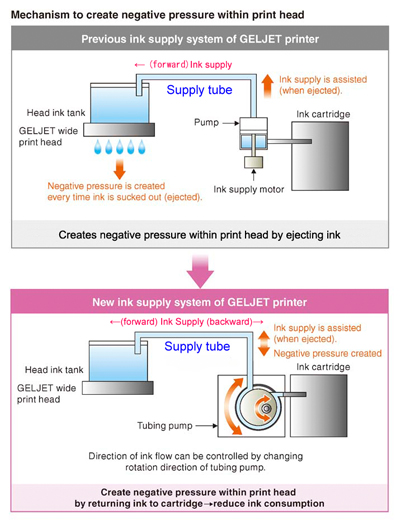- Home
- Technology
- Ricoh's Technology
- Improve efficiency of ink use by minimizing ink waste
Improve efficiency of ink use by minimizing ink waste
Ricoh has developed a technology to significantly decrease the amount of ink consumed for purposes other than printing and use ink in a cartridge.
Is ink used for other than printing?
An ink jet printer, in general, consumes ink in a cartridge for purposes other than printing. When there is an interval of use, for example, ink may dry at the head nozzles or air bubbles may be entrapped. When this happens, ink ejection may become unstable, causing printing to blur or streak. Cleaning is required to prevent this and to recover and maintain normal ink ejection.
Cleaning consumes a bit of ink, so Ricoh has continued our efforts with GELJET printers to minimize the amount of ink discharged without being used for printing. We have also developed an ink supply system to use cartridge ink.
Develop technology to eliminate excessive ink consumption
With the RICOH GX e and RICOH SG series, we have reduced running costs by reducing excessive ink consumed other than for printing. To do so, we have developed the following three technologies.
1. Minimize ink intake during cleaning to the lowest in the industry
To discharge the air entrapped in the nozzle, the air is sucked out with ink by applying a cap on the print head. It is very important to discharge air completely while reducing suction as much as possible. At this time, if ink bubbles, it causes air bubbles to remain inside the nozzle. To eliminate the bubbles, we had to intake and discharge air together with a certain amount of ink.
In the RICOH SG series, Ricoh has decreased discharge to its limits by developing an ink less likely to bubble and also to withdraw ink uniformly from all 384 nozzles arranged on the print head. The industry minimum (as of January 16, 2012) of only 0.0005ml intake per nozzle was achieved while ensuring complete air discharge.
2. Develop a new idea to reuse ink wasted by the ink supply system
An ink jet printer enables stable ink ejection by maintaining negative pressure on the print head. In the past, to maintain negative pressure, a given amount of ink had to be periodically discharged from the head ink tank through the nozzles.
Ricoh has developed a unique feed pump to allow reciprocal transport of ink to maintain negative pressure without discharging ink. This feed pump is incorporated into the RICOH GX e series and RICOH SG series. A tubing pump feeds cartridge ink to the print head for printing. By inverting the drive, negative pressure is created by taking ink in from the print head to the cartridge side (Figure 1).

Figure 1: Mechanism to create negative pressure
A conventional ink jet printer does not have a function to make ink flow backwards from the print head. Therefore another pump is used for suction from the ejection plane at the print head. This is done to create negative pressure. When this is done, because the ink taken out must be discharged, fewer sheets can be printed per cartridge. (The effect varies with conditions, such as how often the printer is used and the number of sheets to be printed.) With the Ricoh system, however, where a tubing pump returns ink, the ink returned to the cartridge can be reused. This sharply improves ink-use efficiency, thereby increasing the number of sheets printable per cartridge.
3. Use up ink in a cartridge effectively
When the ink in a cartridge is depleted, high negative pressure accrues inside a pump. When ink cartridges are exchanged at this time, a certain amount of air will mix in the supply tube, and the cleaning action to discharge air is needed. To avoid this problem, in the past, cartridges needed to be changed while some ink remained. The remaining ink was discarded with the cartridge - so it was futile ink.
With the RICOH GX e series and RICOH SG series, as soon as the ink in a cartridge is depleted, the tubing pump is reversed to suck a minute amount of ink from the print head and relieve high negative pressure inside the pump. This makes it possible to change a depleted ink cartridge without entrapping air. In this way, introducing the tubing pump makes it possible to return ink, to relieve negative pressure in the pump, and to thoroughly reduce unnecessary ink consumption.
Sorted by : field “Inkjet” “Analysis / Simulation” | product type “Ink / Toner”